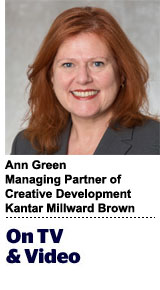 “On TV And Video” is a column exploring opportunities and challenges in advanced TV and video.
“On TV And Video” is a column exploring opportunities and challenges in advanced TV and video.
Today’s column is written by Ann Green, managing partner of creative development at Kantar Millward Brown.
As the battle for consumer eyeballs gets more challenging, advertisers are trying anything to get viewers to pay attention, with one of the latest trends being running live TV commercials.
With companies such as Snickers, 20th Century Fox and Virgin Holidays experimenting with live ads, it’s clear big brands across industries are interested in this new ad format. But the jury is still out on whether live ads actually drive business performance.
One of the challenges live ads face is that they can be expensive. For a live ad to work, it has to feel like an event that captures a specific moment in time. To do that, you need to promote it – an ad for another ad. That creates an added expense typically not associated with commercials.
Aside from the promotional effort behind it, everything about the ad must be coordinated in advance. There is no “take two,” which means it’s critical to prepare in case something goes wrong. For its live ad during Super Bowl LI, Snickers actually capitalized on the potential of something going wrong in a very tongue-and-cheek way by having Adam Driver both deliver the ad and then “apologize” for the same ad with the premise that it had gone “wrong.”
While that may have generated some conversation over the next few days, it’s hard to measure the long-term impact of the ad on sales and brand awareness in the long run. Did it compel consumers to buy a Snickers and ideally improve the equity of the brand?
If live ads are not connected to the brand’s overall marketing strategy, they may not have the desired effect. When advertising campaigns are fully integrated with strong central ideas across all marketing channels they have the most impact.
To go beyond the moment in time, live ads should tie back to a brand’s online campaigns and other initiatives. Snickers, for example, effectively integrated its live ad with its overall brand by doing a 36-hour live stream in advance. This gave Snickers the opportunity to bring in larger audiences, refine the potential live ad in advance with feedback garnered online and let it live on social after.
A great demonstration of where a live ad really worked is when 20th Century Fox ran a live ad for “The Greatest Showman” during Fox’s “A Christmas Story Live.” There was an obvious organic tie-in that lent itself to a live ad. For a live ad to really work, brands need to tap into some kind of “live” element, such as a live performance for a movie.
Another good example is when UK grocer Waitrose in 2016 strapped GoPros onto cows so viewers could see how they live on their farm. This was more of an ongoing program instead of an event. The rationale for going live was clear with an overt tie to the brand’s desire to be transparent about the origins of people’s food.
So, while there are some brands that have figured out that it made sense for them to do a live ad, does it make sense for every single brand?
When Virgin Holidays ran a live ad during an episode of “The X Factor,” it showcased influencers from 18 different destinations to demonstrate that normal people can make destinations a reality, not just celebrities. The campaign involved 90 production crew members who filmed simultaneous scenes of influencers in their destinations, from riding the Pacific Coast Highway in San Francisco to snorkeling in Barbados. The ad was live edited for a 60-second ad.
Sure, it was a cool ad, but could Virgin Holidays have received a similar response by capturing those moments and showcasing them in a more traditional ad platform? Did more people book holidays?
Live ads may have their place, and when done well, they can be extremely moving. However, the short-lived benefit they generate may not always outweigh the extra costs needed to develop and promote the live factor.
Follow Kantar Millward Brown (@K_MillwardBrown) and AdExchanger (@adexchanger) on Twitter.
This post was syndicated from Ad Exchanger.


More Stories
Daily Wire Welcomes Perplexity to Advertise on The Ben Shapiro Show
Here’s the Roundup for the Week Ending March 7
Aflac’s Dan Amos Reveals How He’s Successfully Held Onto the CEO’s Job for 35 Years